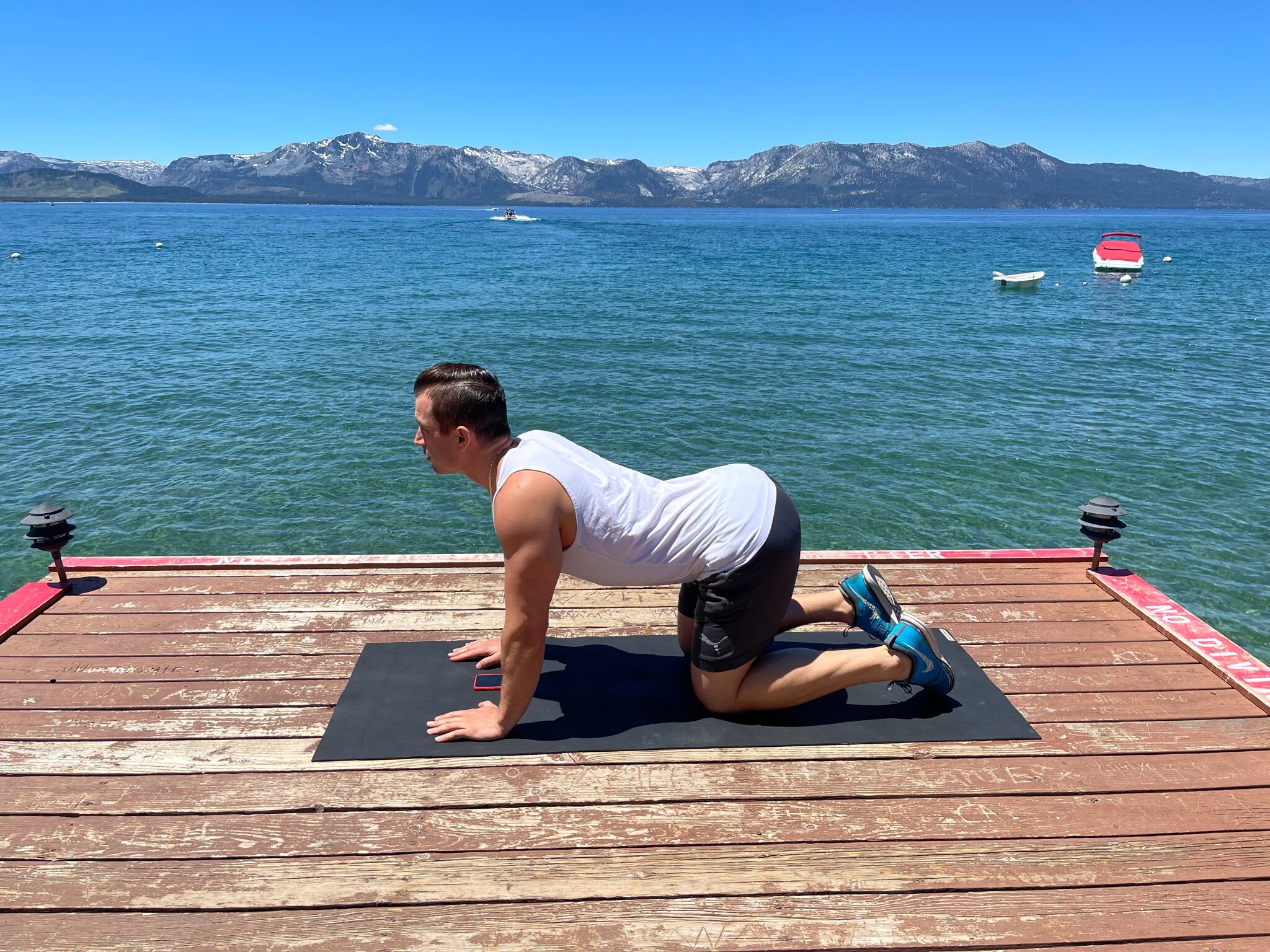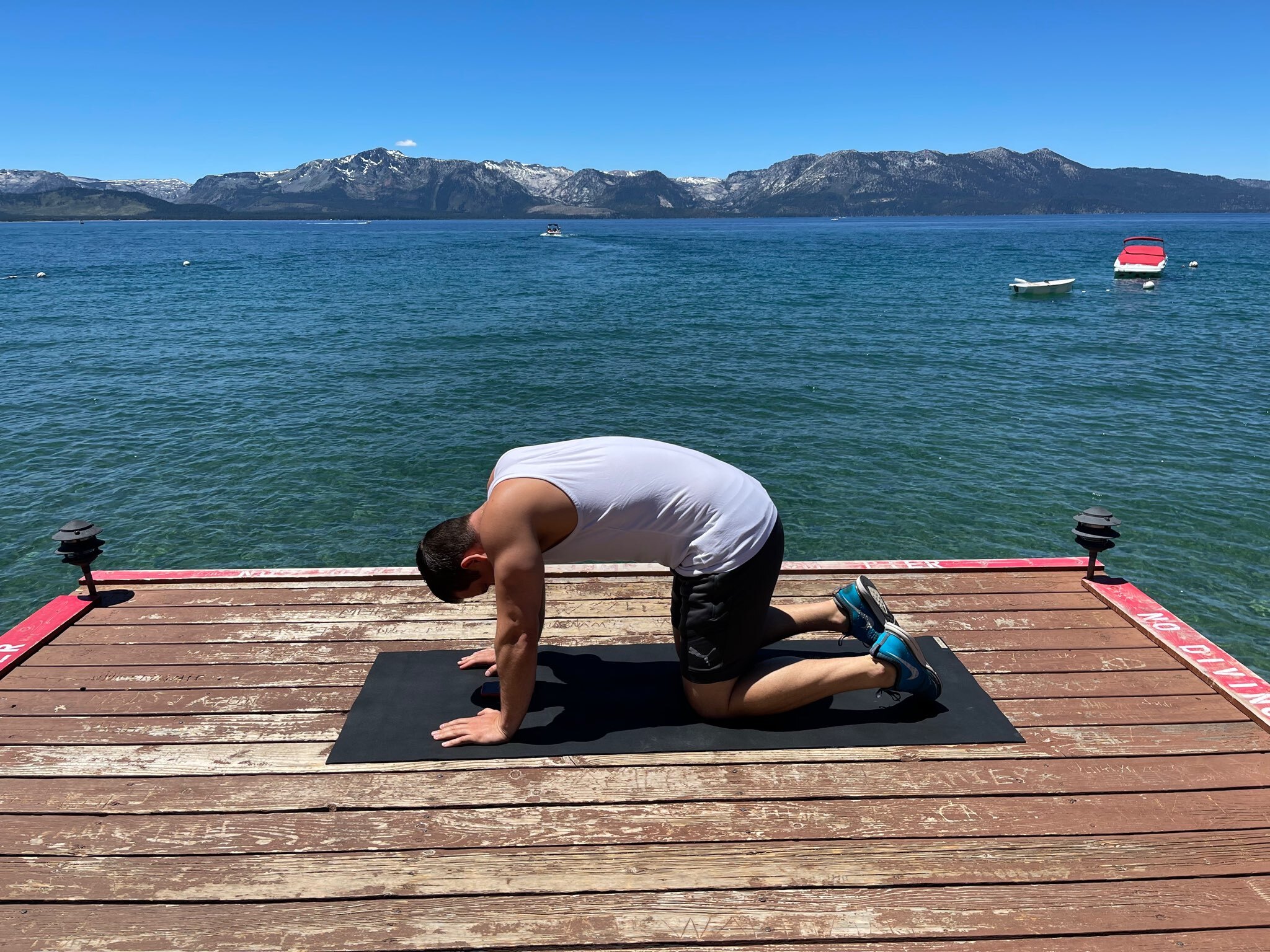How Can Stretching Help With Upper Back Pain?
- According to a study, stretching increases an individual’s range of motion and promotes muscle blood flow(1). It was also suggested that regular stretching loosens tight and stiff muscles(2).
- Some of the stretches that may help manage upper back pain are thoracic extension, cat-cow pose, chair chest opener, scapular squeeze, shoulder roll, and overhead arm reach.
- People should breathe naturally when performing stretching exercises(3). They should not hold their breath when stretching. It is best to inhale and exhale slowly while doing these exercises.
- One should remember to do low-intensity warm-up exercises before starting to stretch. Stretching cold muscles may lead to injuries and sprains(4).
Health Report discusses the causes of upper back pain and the remedies for this condition.
This article will discuss ways to get started on stretching for upper back pain. Included here are some warm-up and stretching exercises to help manage upper back pain.
Health Report will delve into the specific stretching exercises to help alleviate upper back pain between the shoulder blades. Some modifications are also included to make specific stretching routines easier for individuals.
Stretches for Upper Back Pain Relief
Aside from conventional pain treatments, like over-the-counter painkillers, ice or heat packs, and manual or physical therapy, several stretches may help manage upper back pain.
Stretching exercises are crucial to recovering from back pain(5). They promote muscle strength and flexibility(6).
Stretching is said to improve muscle blood flow and the range of joint motions(7). However, it may contribute to back pain severity and cause adverse effects when done improperly.
Doing yoga poses can help in alleviating back pain. According to a study, a 12-week yoga program resulted in significant back function improvement in adults with chronic back pain(8).
Specific instructions should be observed to maximize the effectiveness of stretch routines for upper back pain.
Below is a step-by-step guide for upper back pain stretching exercises. It includes how to prepare for stretching, warm-up exercises, and instructions to properly execute the stretching activities.
Preparations Before Stretching
Stretching aims to induce muscle relaxation by reducing muscle tension and promoting flexibility. Doing stretches regularly may loosen up stiff and tight muscles(9).
To prevent wrong stretches that may lead to more severe injuries, one should avoid bouncing and stretching to the point of pain(10).
They should ensure that the muscles are warmed up before performing the stretching exercises(11). General movements, such as walking, can serve as warm-up exercises before stretching.
The goal of doing a warm-up routine is to get the blood flowing in the muscles using low-intensity activities. When these exercises are done correctly, the body is prepared for the stretching routine(12).
It was suggested that a submaximal aerobic activity may be done as a warm-up exercise before stretching(13). It may help lessen impairments and improve performance(14).
Two to three minutes of warm-up activity is enough to prepare the body for stretching(15).
Proper breathing is crucial during stretching and warm-up exercises. Individuals should observe a natural breathing rhythm throughout the whole stretch routine.
They should inhale and exhale slowly while doing the stretch positions and refrain from holding the breath(16).
A good stretch is held for 5 to 15 seconds only. Stretches that last longer than this and inflict pain are considered bad stretches(17).
Stretching can be done regularly in the morning, after sitting or standing for a long time, or whenever the feeling of stiffness occurs(18).
Upper Back Stretches
Chair Chest Opener
One should remember the following to execute this stretch properly:
- Sit straight on a chair with a backrest. Make sure that the back is rested on the chair.
- Bend the hip and knees at a 90-degree angle. Try to relax as both hands are placed at the nape of the neck.
- Take a deep breath and push the chest forward with a straight back leaning on the chair. Both elbows should be open, and the hands should support the head when leaning.
- Feel the stretch across the shoulders and chest as the neck and back extend. This stretch position targets back extension to relieve pain and discomfort.
- If a chair is not available, stand or sit up straight and put both hands behind or above the head with the elbows and arms pointing outwards.
- Slowly move the arms and elbows backward and gently squeeze the shoulder blades together.
Thoracic Extension
This stretch exercise is best done with a foam roller. To execute the thoracic extension properly, one should:
- Put the foam roller under the thoracic spine (the most extended region of the spine) and let the head and glutes rest on either side of the roller.
- Stretch both arms above the head and feel the extension of the back. Do not forget to breathe when performing this stretch position.
- Repeat this position three times, holding each stretch for ten seconds.
- A chair is an excellent substitute to maximize this stretch’s positive effects if a foam roller is not available.
- Sit steadily and let the upper body rest on the back of the chair. Raise both arms above the head to deepen the stretch.
- This stretch aims to ease upper back and mid-back pain.
Butterfly
This stretching exercise targets the shoulders and the upper back. The butterfly stretch involves standing up or sitting down with a straight back and both palms resting opposite shoulders.
While in this position, one has to move both elbows towards each other and pause for five seconds, then release. This routine can be repeated three to five times.
Scapular Squeeze
This particular stretching routine may help with pain in the upper back between the shoulder blades.
The scapular squeeze can be done standing with both arms relaxed on the sides.
To get started, one must gently squeeze together both shoulder blades backward. This position can be held for ten seconds before releasing to the neutral position.
Repeat this three to five times to benefit from the stretch.
Behind-the-Back Elbow-to-Elbow Grip
To start with the behind-the-back elbow-to-elbow grip, one must perform the following:
- Put the right and left hand at the back.
- Slowly squeeze both shoulder blades together as the chest broadens.
- Grip both arms together with the left arm as the upper arm and the right arm below the left.
- Pause in this position for 15 to 30 seconds or three to five breathing cycles. One breathing cycle is one inhale, and one exhale.
- This stretching exercise can be done sitting down or standing up.
Neck Side Bend
This stretch type can be done standing up or sitting down. It focuses on alleviating upper back and neck pain.
To execute this stretch properly, one must take note of the following:
- By standing or sitting still with the back straight, one must gently tilt the head to the right side.
- Hold this position for ten seconds before gently rotating the head clockwise to the left shoulder.
- When the head is tilted to the left, one must hold that position for another ten seconds before returning to the starting position with the head facing forward.
- One must observe how this stretch is felt on the trap muscles through the neck. This stretching sequence may be repeated two to three times.
Overhead Arm Reach
To start with this stretch, one must sit down with the back straight and both feet parallel to the floor.
With this starting position, the following should be done:
- First, one must raise the right arm above the head with the left arm on the waist. Then, they should reach for the left side.
- One must lightly bend the upper body to the left until the stretch is felt on the right shoulder.
- The exact sequence must be done on the opposite side: with the right hand on the waist and the left arm raised above the shoulder.
- This position can be repeated five times for each side.
Overhead arm reach targets the shoulder and upper back muscles.
Shoulder Roll
With both arms resting on each side, one must start to move both shoulders backward in a circular motion in five rounds.
This exercise can be repeated two to three times.
Cat-Cow Pose


One must do the following routine to do cat-cow pose properly:
- Start in a neutral position where the knees and both hands are parallel on the floor. This pose aims to mobilize the thoracic spine, including the upper back, middle back, and lower back.
- While in neutral position, one must begin stretching with a deep breath as the chest is pushed to the floor and the glutes are pushed upwards. This pose should form an arch on the back.
- This position should be held for at least five seconds before pushing the back upwards and the pelvis towards the floor.
- One must push both shoulder blades away from the spine and ensure that the back is rounded into a “C.” This yoga pose sequence can be repeated ten times.
Chair Rotation
The chair rotation stretch targets the whole thoracic spine (upper, middle, and lower back).
To begin with this stretch, one should:
- Sit sideways on a chair, with the right side of the body resting against the back of the chair.
- Place both legs steadily, with both feet parallel on the floor. Slowly rotate the torso to the right and hold the back of the chair.
- Stay in that position for ten seconds and try to stretch deeper as the torso is twisted.
- Do the same sequence on the other side and repeat three times on each side.
Benefits of Stretching for Upper Back Pain
Poor posture is one of the eminent causes of upper back pain(19). This type of pain can develop gradually over time.
In some cases, upper back pain experienced between the shoulder blades may be caused by muscle strains and sprains due to sports injuries or overuse from doing other activities(20).
This pain may also be a symptom of more severe conditions, like osteoporosis(21).
People who experience upper back pain may feel muscle cramping, aching, or sharp, stabbing pain in the back that may limit mobility(22).
Several qualitative research studies stated positive results with stretching exercises(23). According to Dave Nolan, a physical therapist at Harvard-affiliated Massachusetts General Hospital, stretching must be done regularly(24).
Without proper stretching, the body’s muscles, including the upper back, tend to become tight and short. Incorrect stretches may also result in strains, muscle damage, and joint pain(25).
Stretching daily maintains muscle length, health, and flexibility(26). Having healthy muscles improves balance and helps prevent falls and injuries(27).
It was suggested that stretching and warm-up routines be done within 15 minutes before any physical activity to maximize the exercise’s benefits(28).
A study assessed the effectiveness of traditional Thai self-massage combined with stretching exercises for individuals with low back pain.
Results showed that the group who practiced the Thai self-massage with stretching exercises indicated significant back flexibility improvements compared to the group who did self-care education alone(29).
It was suggested that Thai self-massage with stretching exercises is a promising treatment for disability, pain, and back flexibility(30).
Stretching is also said to be beneficial for lower back pain(31). Research published in 2019 documented the beneficial effects of stretching and strengthening exercises on people with chronic lower back pain(32).
Research findings showed significant positive changes in functional disability, pain, and balance of the patients who received strengthening and stretching interventions three times a day for eight weeks(33).
Another study reported that stretching lessens passive tension, which causes soreness and stiffness(34).
A different set of researchers conducted a study on incorporating dynamic stretch (movement-based stretching) warm-up interventions into the daily regimen of preseason wrestlers’ training(35).
The authors observed sustained and long-term muscular endurance, strength, power, and enhanced agility performance in the wrestlers after this type of intervention was incorporated in their training.
In 2006, a study noted that both static (standing or lying down stretches) and ballistic (intense active stretching) stretches increased the range of motion and stretch tolerance of the study’s male subjects(36).
Additionally, static stretching is said to enhance muscular performance and flexibility(37).
However, a study noted that this type of stretching does not have immediate benefits on muscular injury rate(38).
These two stretches have different effects on tendon stiffness(39). It is advisable to consult a physical therapist before trying any of these stretches.
Tips on How to Get Started in Stretching
Before starting a stretching routine, it is essential to follow safety measures that may prevent injuries and unfavorable side effects.
One should follow these tips when developing a stretching plan(40):
- Practice warm-up exercises. Stretching with cold muscles may lead to tighter muscles. Light activities should be done for at least five to ten minutes before stretching.
- Do not bounce. It is crucial to understand that stretching should be a smooth movement. Bouncing may lead to unwanted injuries and contribute to muscle tightness.
- Do a gentle stretch. Never force the muscles to stretch to the point of pain. If pain is felt, slowly go back to a stretch position that is more comfortable and relaxed. Hold that position for around 30 seconds.
- Stretch for flexibility. As people grow old, muscles become stiff. Stretching may help improve muscle elasticity. Aim for a balanced stretch where a specific group of muscles is targeted.
- Be consistent in following a stretching routine. Flexibility cannot be achieved overnight. To maximize the benefits of stretching, one should aim to stretch regularly, at least two to three times a week.
- Observe good posture and form. In stretching, it is crucial to maintain a balanced shape. Practice stretching regularly to boost balance if one side of the body is tighter than the other.
- Do modified stretches if necessary. It is advisable for some who find it challenging to do some stretching poses and exercises to start with the most comfortable positions to prevent unnecessary injuries.
- People new to stretching are advised to work with a personal trainer who can ensure guided and safe stretching routines.
When to See a Doctor
Stretching may provide relief for back pain. Still, stretching alone does not prevent muscle injuries and strains(41). It is crucial to see a doctor or seek a physical therapist’s medical advice for persistent pain.
Typically, back pain only lasts for a few days or weeks. If the pain continues for more than a week and prevents everyday activities, visit a physical therapist to understand the severity of the condition further.
Knowing the exact cause of back pain helps in providing the most appropriate treatment and therapy.
